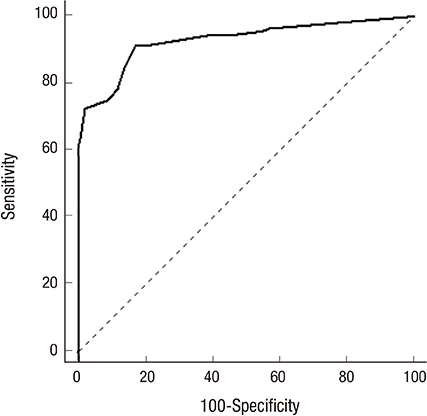J Korean Med Sci.
2015 Sep;30(9):1334-1339. 10.3346/jkms.2015.30.9.1334.
Cross-cultural Adaptation and Linguistic Validation of the Korean Version of the Leeds Assessment of Neuropathic Symptoms and Signs Pain Scale
- Affiliations
-
- 1Department of Anesthesiology and Pain Medicine, Gangnam Severance Hospital, Anesthesia and Pain Research Institute, Yonsei University College of Medicine, Seoul, Korea.
- 2Department of Anesthesiology and Pain Medicine, Severance Hospital, Anesthesia and Pain Research Institute, Yonsei University College of Medicine, Seoul, Korea. breadfans@yuhs.ac
- 3Department of Anesthesiology and Pain Medicine, Ajou University Hospital, College of Medicine, Ajou University, Suwon, Korea.
- 4Department of Anesthesiology and Pain Medicine, National Health Insurance Corporation Ilsan Hospital, Goyang, Korea.
- KMID: 2344161
- DOI: http://doi.org/10.3346/jkms.2015.30.9.1334
Abstract
- Distinction between neuropathic pain and nociceptive pain helps facilitate appropriate management of pain; however, diagnosis of neuropathic pain remains a challenge. The aim of this study was to develop a Korean version of the Leeds Assessment of Neuropathic Symptoms and Signs (LANSS) pain scale and assess its reliability and validity. The translation and cross-cultural adaptation of the original LANSS pain scale into Korean was established according to the published guidelines. The Korean version of the LANSS pain scale was applied to a total of 213 patients who were expertly diagnosed with neuropathic (n = 113) or nociceptive pain (n = 100). The Korean version of the scale had good reliability (Cronbach's alpha coefficient = 0.815, Guttman split-half coefficient = 0.800). The area under the receiver operating characteristic curve was 0.928 with a 95% confidence interval of 0.885-0.959 (P < 0.001), suggesting good discriminate value. With a cut-off score > or = 12, sensitivity was 72.6%, specificity was 98.0%, and the positive and negative predictive values were 98% and 76%, respectively. The Korean version of the LANSS pain scale is a useful, reliable, and valid instrument for screening neuropathic pain from nociceptive pain.
Keyword
MeSH Terms
-
*Cross-Cultural Comparison
Diagnosis, Differential
*Diagnostic Techniques, Neurological
England
Female
Humans
Male
Middle Aged
Neuralgia/classification/*diagnosis
Nociceptive Pain/*diagnosis
Observer Variation
Pain Measurement/*methods
Reproducibility of Results
Republic of Korea
Sensitivity and Specificity
Surveys and Questionnaires
Symptom Assessment/methods
*Translating
Figure
Reference
-
1. Jensen TS, Baron R, Haanpää M, Kalso E, Loeser JD, Rice AS, Treede RD. A new definition of neuropathic pain. Pain. 2011; 152:2204–2205.2. Haanpää M, Attal N, Backonja M, Baron R, Bennett M, Bouhassira D, Cruccu G, Hansson P, Haythornthwaite JA, Iannetti GD, et al. NeuPSIG guidelines on neuropathic pain assessment. Pain. 2011; 152:14–27.3. Jones RC 3rd, Backonja MM. Review of neuropathic pain screening and assessment tools. Curr Pain Headache Rep. 2013; 17:363.4. Bennett M. The LANSS Pain Scale: the Leeds assessment of neuropathic symptoms and signs. Pain. 2001; 92:147–157.5. Yucel A, Senocak M, Kocasoy Orhan E, Cimen A, Ertas M. Results of the Leeds assessment of neuropathic symptoms and signs pain scale in Turkey: a validation study. J Pain. 2004; 5:427–432.6. Pérez C, Gálvez R, Insausti J, Bennett M, Ruiz M, Rejas J. Group for the study of Spanish validation of LANSS. Linguistic adaptation and Spanish validation of the LANSS (Leeds Assessment of Neuropathic Symptoms and Signs) scale for the diagnosis of neuropathic pain. Med Clin (Barc). 2006; 127:485–491.7. Hallström H, Norrbrink C. Screening tools for neuropathic pain: can they be of use in individuals with spinal cord injury? Pain. 2011; 152:772–779.8. Schestatsky P, Félix-Torres V, Chaves ML, Câmara-Ehlers B, Mucenic T, Caumo W, Nascimento O, Bennett MI. Brazilian Portuguese validation of the Leeds Assessment of Neuropathic Symptoms and Signs for patients with chronic pain. Pain Med. 2011; 12:1544–1550.9. Barbosa M, Bennett MI, Verissimo R, Carvalho D. Cross-cultural psychometric assessment of the Leeds Assessment of Neuropathic Symptoms and Signs (LANSS) pain scale in the Portuguese population. Pain Pract. 2014; 14:620–624.10. Li J, Feng Y, Han J, Fan B, Wu D, Zhang D, Du D, Li H, Lim J, Wang J, et al. Linguistic adaptation, validation and comparison of 3 routinely used neuropathic pain questionnaires. Pain Physician. 2012; 15:179–186.11. Bennett MI, Bouhassira D. Epidemiology of neuropathic pain: can we use the screening tools? Pain. 2007; 132:12–13.12. Beaton DE, Bombardier C, Guillemin F, Ferraz MB. Guidelines for the process of cross-cultural adaptation of self-report measures. Spine (Phila Pa 1976). 2000; 25:3186–3191.13. Guillemin F, Bombardier C, Beaton D. Cross-cultural adaptation of health-related quality of life measures: literature review and proposed guidelines. J Clin Epidemiol. 1993; 46:1417–1432.14. Treede RD, Jensen TS, Campbell JN, Cruccu G, Dostrovsky JO, Griffin JW, Hansson P, Hughes R, Nurmikko T, Serra J. Neuropathic pain: redefinition and a grading system for clinical and research purposes. Neurology. 2008; 70:1630–1635.15. Terwee CB, Bot SD, de Boer MR, van der Windt DA, Knol DL, Dekker J, Bouter LM, de Vet HC. Quality criteria were proposed for measurement properties of health status questionnaires. J Clin Epidemiol. 2007; 60:34–42.16. Yun DJ, Oh J, Kim BJ, Lim JG, Bae JS, Jeong D, Joo IS, Park MS, Kim BJ. Development of Korean Neuropathic Pain Questionnaire for neuropathic pain screening and grading: a pilot study. J Korean Neurol Assoc. 2012; 30:15–25.17. O'Connor AB. Neuropathic pain: quality-of-life impact, costs and cost effectiveness of therapy. Pharmacoeconomics. 2009; 27:95–112.18. Schestatsky P, Gerchman F, Valls-Solé J. Neurophysiological tools for small fiber assessment in painful diabetic neuropathy (comment letter). Pain Med. 2009; 10:601. author reply 2.19. DeLong ER, DeLong DM, Clarke-Pearson DL. Comparing the areas under two or more correlated receiver operating characteristic curves: a nonparametric approach. Biometrics. 1988; 44:837–845.20. Backonja MM. Need for differential assessment tools of neuropathic pain and the deficits of LANSS pain scale. Pain. 2002; 98:229–230. author reply 30-1
- Full Text Links
- Actions
-
Cited
- CITED
-
- Close
- Share
- Similar articles
-
- Characteristics of Neuropathic Pain in Patients With Spinal Cord Injury
- Evaluation and diagnosis of neuropathic pain
- Clinical Scale for Neuropathic Pain
- Cross-cultural Adaptation of the Korean Version Of the Oswestry Disability Index (ODI)
- Validation in the Cross-Cultural Adaptation of the Korean Version of the Oswestry Disability Index



